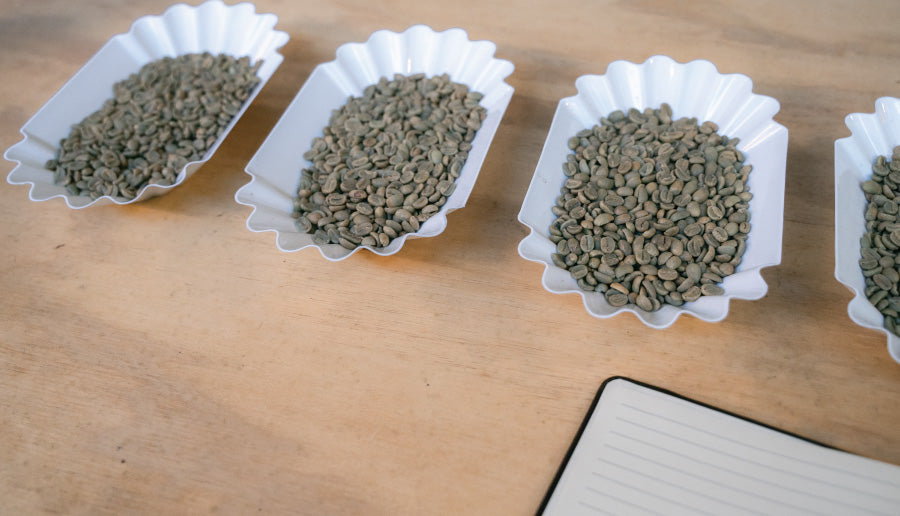
Hi my name is Al, and I have a coffee problem Well, not a problem as such. More a habit. Really, I just think too much about coffee. I’ll explain why, but first: some personal history. I have a background in the wine industry.
In the last 18 years or so I have worked a range of roles in large and small vineyards and wineries and wine companies; been a part of growing and making wine, retail, wholesale, consulting – you name it! All this exposure built up a passion for every aspect of wine; from the vineyard to the cellar, cellar door and store shelf, restaurant table, and beyond. As a result, I overthink what I drink. The connection, you see, is that it takes a lot of coffee to make wine! (and beer, but that’s by-the-by) My passion for wine crossed over to coffee very quickly, leading to a keen learning about the bean, the roast, the making, and the appreciation.
This is where tasting notes come in. Tasting notes for coffee can be a bit like wine descriptions. Sometimes not all of us taste or smell the same things, or all the things that are ‘supposed’ to be in the glass or cup. Often, what we eat, our preference for sweetness or acidity, even what we remember having smelled or tasted in the past, help to bring flavour notes out. You may love citrus – lemons, lime, grapefruit and the like – so your palate and flavour memory will always look for what is similar to those things. And since we all eat and drink different things, and have diverse backgrounds of smells and flavours in our memories, we are likely to taste the same coffee rather differently.
This is why we aim for just a few notes of the real highlight flavours and aromas. We also want to pick elements that can be recognisable, and not just simple or vague stabs at what could be there. Settling on tasting notes can be a difficult process, with many coffees and much discussion. ‘Cupping’ is broadly practised form of coffee tasting. A method used around the world and a great way to understand how broad a variety of coffees from different regions and roasteries can be. The beans are roasted and ground coarse/medium coarse before being brewed with recently boiled fresh or filtered water. After steeping for 3 minutes, break the crust of grind and inhale the aromas. Leave for a further 2 minutes and carefully scoop the grinds out and discard. Now comes the fun part: taste with a spoon, sucking in air as you sip (like slurping soup). This helps to atomise the coffee in the mouth, providing maximum surface area of the coffee to aerate and coat your palate. Make notes to what you taste and smell, revisiting to confirm those notes only after you’ve worked through the range of cups for tasting. We also form our tasting notes by making coffees! A hard task, but somebody has to do it! Part of tasting notes is understanding that we all have different ways of making coffee. Some may enjoy espresso, some lattes, others French press, even stovetop, pour-over, cold brew, siphon and more; This is where tasting notes can get tricky.
Once coffees are made, we smell, sip, think, and sip again. Once there are a few ideas of the key elements we share those thoughts. “I get chocolate”, “I taste citrus”, “the fruit is rather sweet and tangy”, and so on. Really, we are talking about what we experience and build up from there, with more sips and sniffs to get more information. One line of discussion may go... “I taste citrus”, “like orange or grapefruit or something else?”, “orange, I think”, “I find it fairly sweet, not so tart but juicy”, “and with a hint of bitterness, but a fruity kind” “like naval or Valencia oranges?”, “Valencia?”, “yeah, sweet but tangy like mandarins, only juicier” and so on. Flavours and smells have a lot of cross-over and really, the discussion aspect is a great way to find a way through the mist to what best describes the various experiences together. When comparing something like acidity, there are so many forms to choose from. Even just in citrus, lemons, limes, and oranges all have a different intensity and flavour to the acidity. This is due to varying concentrations of many different types of acid; Tartaric, Citric, Ascorbic, Acetic and more. We usually talk about descriptions like sharp, sour, tart, bitter, subtle, fruity, tangy, and others. It’s a great way to draw a comparison between flavours and how they present, especially if comparing one coffee to another with similar characters.
With that, let’s look at 3 flavour components often found in coffee...
Chocolate. Due to the roasting process, a chocolatiness can become quite pronounced in the flavour of coffee. Usually considered sweet in flavour, chocolate can varying in darkness and richness depending on how dark or light a grind, and even whether blended of single origin. With Dark chocolate, think in terms of bitterness too. Over 60% cocoa mass can get rather bitter but still has a
distinct taste.
Nuts. As a roasted bean, nuttiness is a regular flavour contributor. But which nuts? You might like to think back to the last time you had some plain pistachios or walnuts. What about the toasted quality? Almonds are a great flavour because they can come in sweet or bitter forms like almond milk or marizipan. Descriptors like nuts give a fullness of flavour or balance out fruitiness depending on the other elements. Descriptions like chocolate and nuts can lead to words like ‘rich’ and ‘texture’, we’ll discuss this and ‘body’ further down.
Acidity is the other point of the triangle. This is where the fruit tree lives. And what a tree! Most foods have some form of acidity, usually balanced with a natural sweetness. Lemons and limes, tomatoes apricots all can be described as acidic, but things like mint, capsicum, milk and cream too. What matters is how that are balanced, and what is most prominent.
When I taste, I make notes. It’s the only way that has worked for me to list what I taste and smell without confusing things. Super easy to revisit too, especially in discussion. I sniff, and think, and write. Revisiting the aroma several times before tasting. All the while thinking “is there anything here I recognise?”. Over a couple of attempts, I aim to nail down at least 2 components, hoping for a few more as my senses tune in. Tasting is similar. Small sip, move it around the mouth, chew slowly, suck in some air over the tongue, chew some more. Each sip is a chance to confirm what I might have smelled earlier, and find new flavours that reside only for the palate. After a few notes, I take another sniff and sip, and close my eyes. I am a visual taster, I like to ‘build a picture’ of what my palate senses. The best way I know how is to imagine a table or bowl and start adding the flavours and I find them. Perhaps placing dark chocolate in the bowl, along with toasted walnuts, a small chunk of honeycomb, some pieces of dried pineapple, and a handful of fresh oranges and a wedge of lime.
For me, this flavour picture becomes clearer after a couple of tastes, and some of those items may become more or less prominent, eventually cementing in my head what that coffee is.The hardest part is then taking those notes and that picture and distilling it into the few highlights that as many drinkers as possible could experience. This means separating my preferences and thinking about how others drink their coffee.
As noted earlier, we all have different palates and diets, and these inform what we taste and experience. In formulating tasting notes, our goal is to provide a description of the key components that set our coffee apart from others. These are the key flavours that should be present or stand out no matter how you make your coffee. I’m an everyday espresso drinker, but equally enjoy a stovetop and Aeropress, and in summer I make cold brew. My aim is to have notes that carry over through each of those methods, and others. Part of the thinking around having tasting notes that can span brewing methods is that we all have a different idea of ‘body’ in coffee. Some of us like full-bodied, rich drinks; some prefer lighter, expressive brews. Body is how something ‘feels’ in the mouth. Big, small, slick, intense, sharp, rich, full, light, heavy; all these are ‘body’ words that help build more of the picture when factored in alongside the flavour notes.
I usually describe body in two ways: size, and weight. Size, for me, indicates how much of my palate, or mouth, can taste the coffee and any one time. Sometimes its like a large or cloud of flavour has filled up the space. This cloud might be very intense, and feel like it weighs heavily on my tongue. I would describe this as “full-bodied”, a sensation of oiliness that coats the mouth would make it rich.
Alternatively, I may try a coffee that seems like a small balloon floating on the palate, with a delicate kind of acidity that I’d describe as “light and airy” while the prominent flavours are expressive.
For anyone keen to school their palates and learn more about appreciation of flavour elements and describing them, and understanding how to categorise the body of a coffee, there are a few things I’d recommend.
Try different brewing methods. Tried either side by side, or for a period of time instead of the preferred method, trying different brewing methods allows us to see the differences they each draw out from the bean. Take notes. Make some coffees, and take time to think through all the things you smell and taste.
Make notes, draw pictures, and just generally think through the different experiences in each cup. This isn’t about scoring or assessing one cup better than another. It’s a thought experiment, geared toward building a more nuanced view of what goes into each brew.
Test yourself. Can you remember what something tastes like and describe it in 100 words? This is a good way to articulate all the different elements within a single flavour. And is that description something that another person could read and know what flavour you’re expanding on?
Build a flavour memory. Take every opportunity to make a mental memory of what different things taste like. Write notes if you need/want to, it helps to be as descriptive as possible. Also be brave and try new and different things. This is how your palate becomes more educated and able to spot interesting and diverse flavours.
Teach yourself how to recognise sweetness, bitterness, and acidity in differing balances. Make a large batch of coffee, a French press say, and into several small cups pour a portion of coffee. To each cup (except for 1 that remains untouched), add a drop of lemon or lime or orange juice, or a pinch of sugar, or a pinch of salt, and so on. Working your way tasting and considering these elements will help to show the differences even a small change in acid, bitterness or sweetness
makes.
The best way to practise is to be intentional about it. Getting better at describing what you taste or smell takes time and repetition, ideally doing it with others and bouncing ideas of each other. After all, doesn’t coffee taste better when you’re enjoying it with friends?

